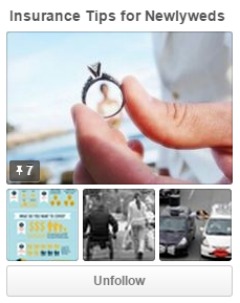
by MelanieD | Oct 12, 2015 | Blog
Pinterest is a pinboard-style photo-sharing website that allows users to create and manage theme-based image collections such as events, interests, and hobbies. Users can browse other pinboards for images, ‘re-pin’ images to their own pinboards, or ‘like’ photos (Wikipedia). Just as with Facebook, Twitter and other social media sites, people can “follow” other users.
Insurance agents sell intangible products and services, and many people consider insurance to be a boring necessity that doesn’t create much excitement. Building relationships is important for all salespeople, perhaps even more so for insurance agents.
Nearly 70% of Pinterest users are females ages 25 – 34. This demographic is likely doing one or more of the following activities:
more of the following activities:
- Paying off student loans
- Purchasing a new car
- Renting an apartment
- Buying a first home
- Getting married
- Starting a family
Used strategically and with an understanding of the demographics of this community, Pinterest can be another way for you to create positive PR for your business and connect with potential clients.
With that in mind, an Insurance Agency would do well to consider the following types of Pinterest Boards:
Fun Car Pictures
House Decorating Ideas
Healthy Habits
Dream Home Inspiration
Wedding Inspiration
Baby/Nursery Decor
For B2B Agencies, consider creating boards with the following themes:
Office Etiquette Tips
Employer Resources
Our Partners
Small Business Tips
Financial Infographics
And finally, all agencies should remember to keep a sense of personality and a personal touch:
Our Community
Our Office
Our Blog
Our Charities
Our Staff
As Seth Godin points out, effective social media turns strangers into fans, fans into customers, and customers into salespeople. Creating an engaging presence will help any business achieve those goals, regardless of the outlet.

by MelanieD | Sep 26, 2015 | Blog
Negative comments, nasty rumors, 1-star reviews . . . less than positive online statements can hurt business owners in so many ways. Not only can they have an adverse effect on the success of the business, but quite often, they can cause emotional pain to the business owner as well. Many small business owners have invested everything they have into their business, including finances, time, even blood, sweat and tears, and some can’t help but take these words personally. The business owner who has very tough skin may not take these words to heart, but that is not the case for everyone. Regardless of the business owner’s sensitivity, these issues must be dealt with gracefully and respectfully. Let’s explore some opportunities for letting our best customer service skills shine when it seems like everything is on the line.
Scenario: The Facebook “Anytown, USA Community Information Group” with over 10,000 members  is very active. Newcomers to Anytown, USA post questions asking for referrals on everything from child care to hair dressers to restaurants to where to buy new tires for their car. Generally, the conversation is helpful and positive, and the members of this online community are excited to share their positive experiences with others. But, on occasion, there is the disgruntled consumer who decides to vent his dissatisfaction publicly, and there ensues a tirade against a local business, with many of the group members joining in on the conversation. Eventually, the owner of said business finds out about the conversation, and knows something has to be done, but what?
is very active. Newcomers to Anytown, USA post questions asking for referrals on everything from child care to hair dressers to restaurants to where to buy new tires for their car. Generally, the conversation is helpful and positive, and the members of this online community are excited to share their positive experiences with others. But, on occasion, there is the disgruntled consumer who decides to vent his dissatisfaction publicly, and there ensues a tirade against a local business, with many of the group members joining in on the conversation. Eventually, the owner of said business finds out about the conversation, and knows something has to be done, but what?
Ideally, the business owner can connect with the original unhappy customer in a more private manner and settle the issue civilly. If the customer is truly satisfied with the outcome, the business owner should respectfully ask the customer to remove the negative comment, and to perhaps post in the group again, this time thanking the business owner for settling the matter and letting the community know of their acceptable agreement.
However, if they cannot come to an agreement, then it’s time for personal convictions on the part of the business owner. One of the hardest things for a business owner who feels she’s being “bullied” is to sit quietly by, watching the horror unfold online. Some business owners decide to let the tirade work itself out, because they don’t want to be part of the negative conversation, or they want to “take the high road.” Sometimes, the best practice is to defend the business and the employees, and make a positive statement without getting into a “spitting match.” And sometimes, all it takes is for some of the business’s biggest fans to come to the rescue and let them take the reins.
 Bottom Line: in talking to consumers and business owners alike, the theme surrounding this mentality seems to be the same: those taking the time and energy to publicly trash a local business owner are not to be taken very seriously, and like Mom always said, “If you ignore them, they’ll go away.” Maybe Mom’s advice should be applied to this situation as well.
Bottom Line: in talking to consumers and business owners alike, the theme surrounding this mentality seems to be the same: those taking the time and energy to publicly trash a local business owner are not to be taken very seriously, and like Mom always said, “If you ignore them, they’ll go away.” Maybe Mom’s advice should be applied to this situation as well.

by MelanieD | Sep 14, 2015 | Blog, Constant Contact
Non-profit and membership organizations face challenges that are not always known in the business-to-business (B2B) and business-to-consumer (B2C) world. Primary among these challenges are limited financial resources and limited staffing resources. Add to that the sense of ownership among the organizations membership and/or donors, and the feeling of overwhelm can be incredible.
One of the easiest ways for an organization to communicate with the members/donors is through email. This can take many shapes including announcements, event promotion, surveys and feedback, calendars, and of course, newsletters. Let’s take a look at best practices for each of these digital communications.

Announcements are a great way to introduce your new Executive Director, Board of Directors, or even spotlight a dependable volunteer! All it takes is a short bio, a high-quality photo, a subject line, and voilá, you’re done. Short and sweet, announcements are generally limited to a single subject, and the recipient is kept in the loop of what’s happening with the organization.

Event Promotion. Generally speaking, non-profits hold fund-raising events throughout the year. Using a product such as EventSpot from Constant Contact makes event planning even easier by collecting many types of data including:
- Detailed attendee data, that is completely customizable
- Printing of name badges for attendees that is formatted to several Avery© template options
- Collecting payments for tickets or extra items available for purchase
- Create and schedule customized emails prior to and post event
- Even solicit items for the event, such as silent auction items, etc

Surveys and Feedback are invaluable tools for any business or organization. They provide insight and can offer market research, when utilized with careful thought. Many non-profits communicate with their subscribers to gather a variety of information, for example:
- Pre-event suggestions (would you prefer a DJ or a live band at the gala? Assigned seating or open table seating? Limited plated dinner options or buffet-style dinner?)
- Post-event feedback (on a scale of 1 – 5, rate the quality of the acoustics at the gala; what, if anything, would you suggest for additions to the silent auction for next years gala?) TIP: keep surveys to a maximum of 6 – 8 questions, and include an option for respondents to add their own additional comments
Calendars. Most likely, your organization has multiple events and activities taking place, including standing committee meetings, planning meetings, business mixers, and such. While this information will be posted on your website, sending a weekly or bi-weekly calendar update, with minimal information that is easy to read, is always a good reminder for your subscribers. TIP: include a link to your website event calendar for readers to get all the details.
Newsletters are probably the most commonly-used e-communications in member organizations, non-profits, churches, PTA, etc. And for good reason: there is a LOT of information that the subscribers need to know. This is a great place to offer overviews of upcoming events, the calendar, and announcements. And, data suggests that organizations such as these can actually send more detailed email newsletters than typical B2B or B2C marketing emails due to the sense of ownership among the members/donors. Parents want and need to know what’s happening at their child’s school, parishioners desire to know what’s happening in addition to what was printed in last Sunday’s bulletin, chamber members want to know the newest members to join, and so on. There are several studies that suggest using an unusual, catchy subject line will result in a higher open rate; however, use what works best for YOUR subscriber preferences. Not sure what they want to see in the subject line? Ask them! TIP: include links to your website for readers to get the details on the information that is most pertinent to them, and keep the digital format easier to read.
For details on the most recent data regarding email campaigns for nonprofits and other member organizations, check out this blog from the experts at Constant Contact.
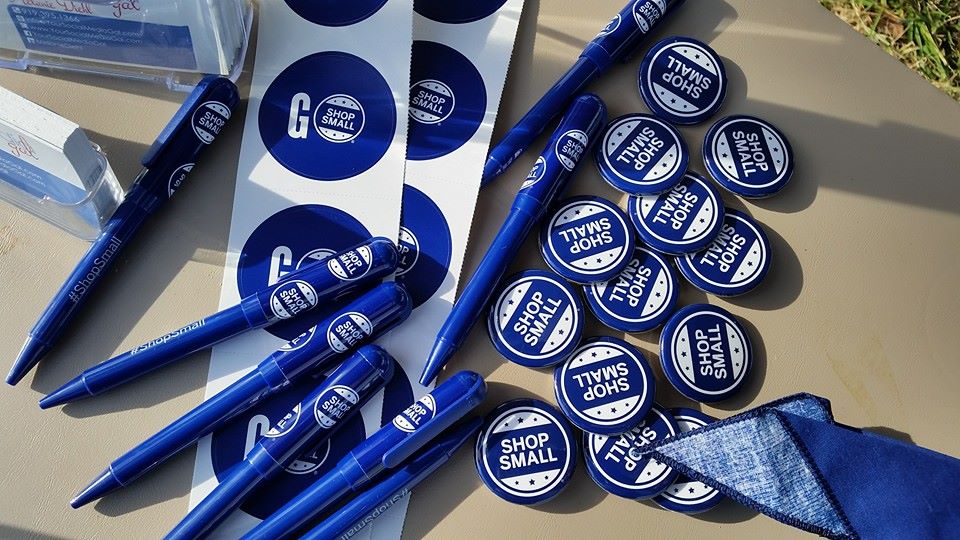
by MelanieD | Aug 26, 2015 | Blog
It may be August, but it’s never too early to start planning for the holidays. If you start now, you have time on your side, and you can stage a successful Small Business Saturday event that will have everyone talking!
Saturday, November 28th is the date for 2015 Small Business Saturday. Not sure what Small Business Saturday is? Here’s some background from American Express®, the founder of the annual event:
“First there was Black Friday, then Cyber Monday. November 27, 2010 was the first ever Small Business Saturday. Small Business Saturday is the day we celebrate the Shop Small® movement to drive shoppers to local merchants across the U.S.¹
“Shop Small® is a movement encouraging people to shop at small businesses; millions of individuals, businesses, and communities have embraced it nationwide. . . As a small business owner, you [have access to] free marketing materials, including in-store signage, social media posts, and email templates, to help you promote your business. You can also read stories of how other small business owners have made the most of Shop Small® marketing materials.²
“More than 200 organizations have already joined American Express OPEN, the company’s small business unit, in declaring the Saturday after Thanksgiving as Small Business Saturday.¹”
So, what can YOU do to make your event a success? Here’s 6 ways to rock your Small Business Saturday

1. Plan a unique event
Have an early bird sale, offer free donuts for first 50 customers, hold a scavenger hunt for items in your store, etc. Tell your current clientele about your Small Business Saturday event in your email campaigns and talk about it on your social media sites
2. Use a count-down calendar
Download a count-down calendar to add to your website, add a paper count-down calendar in your store, or share the Small Business Saturday countdown calendar on Facebook and Instagram.
3. Coordinate with other Small Business Saturday participants
Work with another local business to offer creative packages: buy a donut in my shop, get 20% off your purchase at the hardware store–just show the donut receipt. Be creative and have fun, and experience the excitement with other local merchants.
4. Talk about it on social media
Small Business Saturday has done the hard work: social media posts and hashtag campaigns have already been created–jump on the bandwagon. Tweet about it, post it on Facebook, tag your Instagram photo. No need to reinvent the wheel!
5. Collect contact info at your event
Make it easy to collect email addresses: use QR code to join your list, text to join, paper sign-up at register, enter into POS at time of sale, customize your printed/digital receipts with your social links to follow/like, etc. Give them a reason to join your list—maybe offer an additional discount that is only good for your Small Business Saturday customers. Think outside the box!
6. Follow up, follow up, follow up
Well before your event, create your email follow up campaigns. Then, on Sunday (or Monday), just upload your new contacts, and hit the send button. Make it a little easier on yourself.
Using these methods, you are sure to create some unique, successful campaigns. Be sure to share your success stories with your local media and online. For more information about Small Business Saturday, visit www.shopsmall.com
Sources:
¹ https://www.americanexpress.com/us/small-business/shop-small/faqs
² https://www.facebook.com/SmallBusinessSaturday/info?tab=page_info
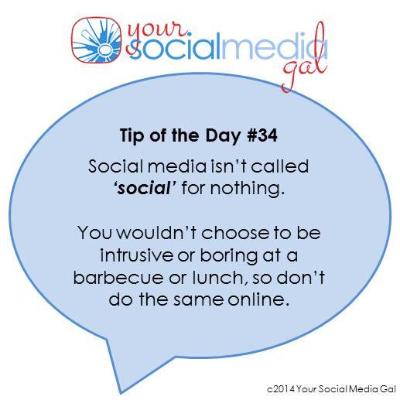
by MelanieD | Aug 11, 2015 | Blog
Scenario: you decide to sign up for a Facebook account and find out just what this Facebook thing really is. You upload a profile picture and maybe a cover photo, add some details about your life; you then proceed down the path of collecting friends: your family, your college buddies, your co-workers, and maybe even some real-life friends! Perhaps you get caught up in watching funny videos, or taking those silly quizzes (just what color is YOUR aura, anyway), or finding out what’s happening in your community.
As time progresses, you discover that some of your favorite businesses have a presence on Facebook, so you decide to “like” their page and keep up with their latest news. You are invited to join a group or two—Motorcycle Maniacs of Minnesota or Anytown Buy-Sell-Swap Group—something that is of interest to you. You are really getting the swing of this!
And then, BAM—it happens. A friend recently started her own business selling {cosmetics, jewelry, cleaning products, fill-in-the-blank} with a direct sales company, and now, all she posts about is her product. All the time. Never telling her personal story, just pushing her business, and it’s blowing up your timeline. You are not interested in her product, but just want to be friendly. So now what? Unfriend her? Unfollow her?
Recently, this showed up in my timeline, and it really hit home. I messaged Tiffany and asked permission to screenshot the post and write about it, because honestly, we’ve all been here!

If her friend had been using a Facebook Business Page, as is appropriate and follows terms of service, Tiffany most likely wouldn’t have felt imposed upon. Not only that, the business owner would have access to important statistics and insights, the ability to purchase ads, and respect her fans and followers.
Another option for Tiffany’s friend is to promote her business/product in a group, as long as again, she follows the terms and conditions set forth by the group admin. Too many times, however, a business owner will create a single post and then proceed to blast the exact same post to multiple groups all in a matter of five or ten minutes. Chances are pretty good that Tiffany is a member of more than one of the groups she’s posting in, and there Tiffany is again, being bombarded with the same, repetitive message. The best practice when promoting in groups is to change up the message, or at least post them at different times or days.

Even when using a proper business page, or promoting in a group, it’s important to respect your fans and followers. Business coach and social media specialist Des Walsh says you wouldn’t choose to be intrusive or boring at a barbecue or lunch, so don’t do the same online. “Find out how to participate in conversations on social media — share information and ideas without constantly saying ‘buy my stuff,” Walsh says. “That way you will build trust and people will recommend you.”
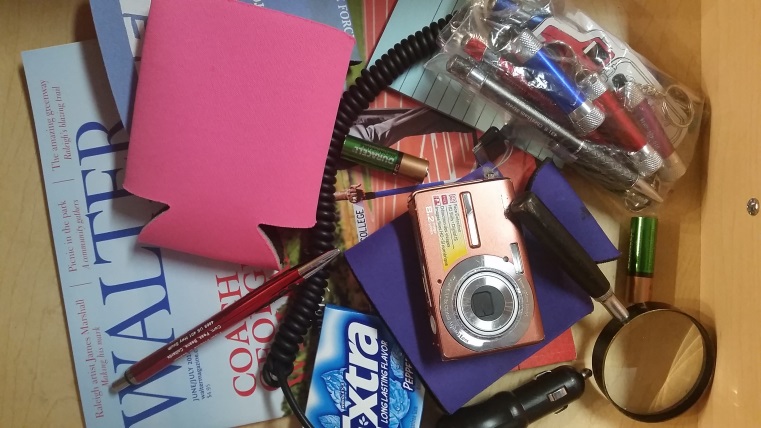
by MelanieD | Jul 21, 2015 | Blog
This is a picture of my real junk drawer. *Notice the plastic baggie full of flash lights, key chains and pens–all from the same company, hoping I’ll call them someday. And the can koozies hiding among the phone charger and batteries.* Admit it, you have a junk drawer, too: the one filled with odds and ends of promotional pens, stress balls, and notepads. Maybe you picked up these items at a business expo or local event. Maybe you even used it. Or maybe it just got tossed into the junk drawer. As business owners, we understand these items all have a place in marketing, but the important question is this: do you have a complete, comprehensive marketing strategy in place for your promotional products?

One of the most effective uses of promotional products I have seen is a simple fly swatter. But what takes this fly swatter from ordinary to extraordinary is that it is branded by an exterminating company and given to new homeowners who are making that all important decision: who do I call for “fill-in-the-blank.” This is marketing branded promotional products with a clear purpose!
Some other smart uses of smart uses of promotional products I’ve seen include:
- The sponsor of a beer garden at an outdoor festival uses branded stadium cups. Each time a consumer purchases a new beer, a new cup is offered. I actually saw some event attendees collecting their cups like it was a trophy!
- A home security company provides key fobs to new homeowners in a welcome basket provided by the Real Estate agent. This is a double benefit, as the homeowner has his keys in his hand every day, and the home security company is being endorsed by the Realtor®, someone the homeowner has come to trust explicitly.
- For B2B companies, a local printer offers mints in a branded tin. Every time the business owner heads into a meeting, she pops a breath mint, and sees the printers logo.
In a nutshell, consider these thoughts when creating a promotional product marketing campaign, just as you would any other marketing campaign. Understand the objective. Is the goal of your promotional campaign to build brand awareness? Boost sales? Show customer appreciation? Knowing the answer at the start will help you to proceed in the right direction with your promo campaign. Your item could: spark a conversation, be useful, make people smile, create trust, or solve a problem.
So, even if it’s just a fun new twist on your promotional can koozie or water bottle label, can you think of ways to use these ideas in your next promotional product marketing campaign, that won’t end up in someone else’s junk drawer?


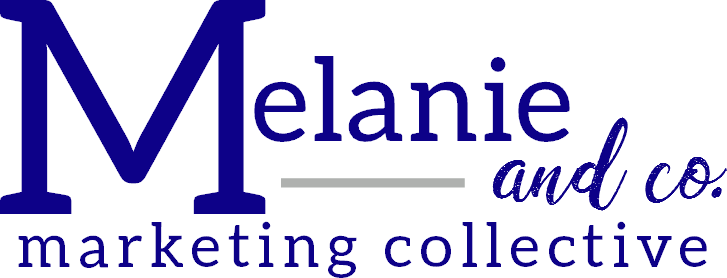


 is very active. Newcomers to Anytown, USA post questions asking for referrals on everything from child care to hair dressers to restaurants to where to buy new tires for their car. Generally, the conversation is helpful and positive, and the members of this online community are excited to share their positive experiences with others. But, on occasion, there is the disgruntled consumer who decides to vent his dissatisfaction publicly, and there ensues a tirade against a local business, with many of the group members joining in on the conversation. Eventually, the owner of said business finds out about the conversation, and knows something has to be done, but what?
is very active. Newcomers to Anytown, USA post questions asking for referrals on everything from child care to hair dressers to restaurants to where to buy new tires for their car. Generally, the conversation is helpful and positive, and the members of this online community are excited to share their positive experiences with others. But, on occasion, there is the disgruntled consumer who decides to vent his dissatisfaction publicly, and there ensues a tirade against a local business, with many of the group members joining in on the conversation. Eventually, the owner of said business finds out about the conversation, and knows something has to be done, but what? Bottom Line: in talking to consumers and business owners alike, the theme surrounding this mentality seems to be the same: those taking the time and energy to publicly trash a local business owner are not to be taken very seriously, and like Mom always said, “If you ignore them, they’ll go away.” Maybe Mom’s advice should be applied to this situation as well.
Bottom Line: in talking to consumers and business owners alike, the theme surrounding this mentality seems to be the same: those taking the time and energy to publicly trash a local business owner are not to be taken very seriously, and like Mom always said, “If you ignore them, they’ll go away.” Maybe Mom’s advice should be applied to this situation as well.








